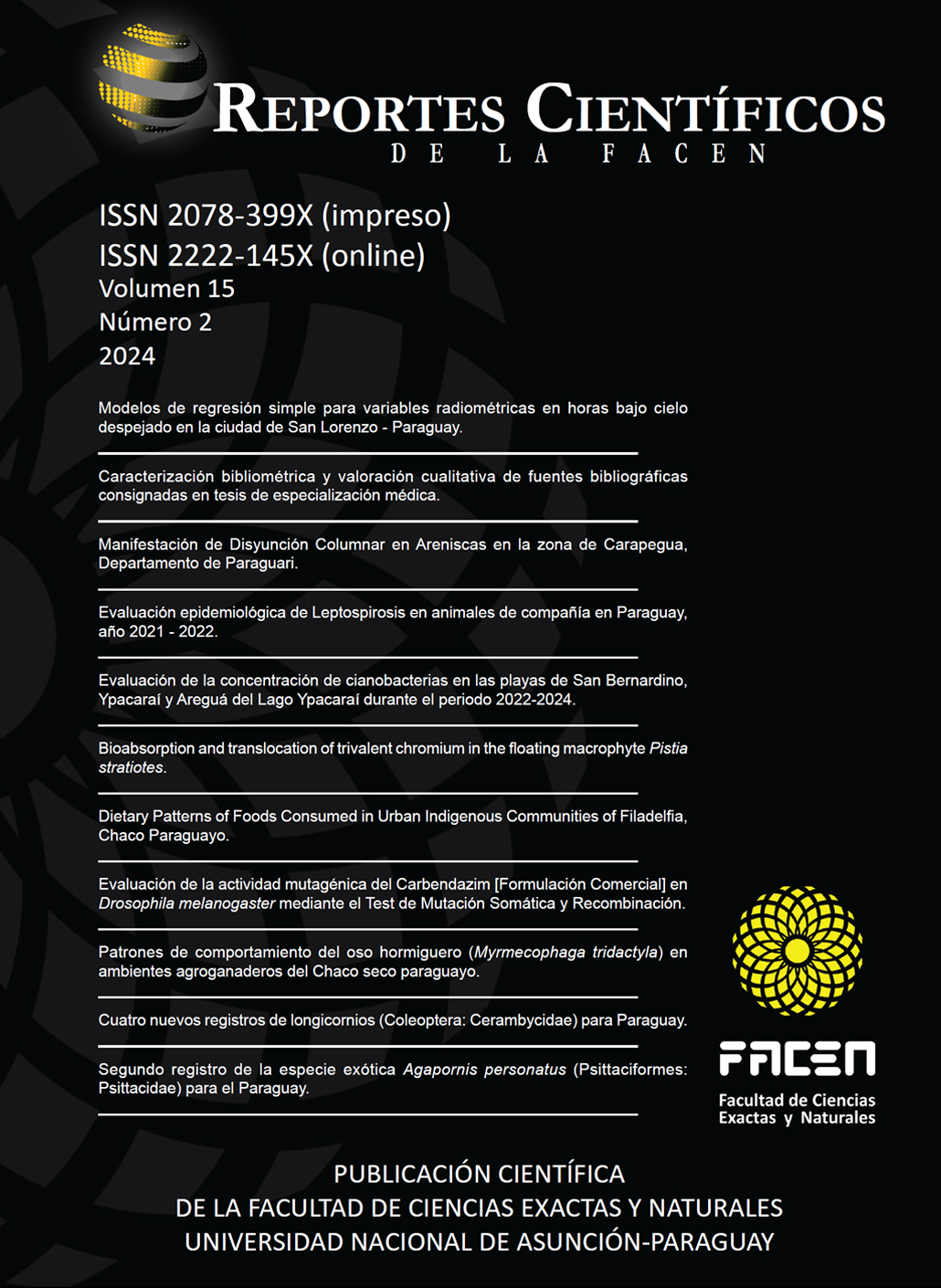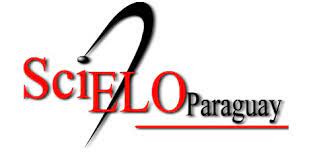Bioabsorption and translocation of trivalent chromium in the floating macrophyte Pistia stratiotes
DOI:
https://doi.org/10.18004/rcfacen.2024.15.2.067Palabras clave:
cinética de eliminación, fitorremediación, metal, factor de bioconcentraciónResumen
En este trabajo se evaluó la capacidad de P. stratiotes para absorber, transferir y eliminar cromo trivalente en solución acuosa de sulfato básico de cromo en diferentes concentraciones, con un enfoque en posibles aplicaciones en la fitorremediación de efluentes de curtiembres. También se evaluó la acumulación en los tejidos de la planta. Las concentraciones de las soluciones utilizadas fueron 2.14, 4.90, 11.98, 25.37 y 43.87 mg.L-1 y el período de exposición del macrófito fue de 48 horas. Al final del experimento, los porcentajes de eliminación de cromo trivalente fueron 90.6%, 91.4%, 88.6%, 79.9% y 64.6%, respectivamente. La macrófita P. stratiotes mostró una alta capacidad para eliminar cromo trivalente de soluciones ácidas, y se observó una mayor acumulación del metal en las raíces que en las partes aéreas, con baja translocación desde la raíz hasta la parte aérea: TF= 0.09, 0.06 y 0.05 y factor de bioconcentración (BCF) 4416, 1496 y 892 para 2.14 a 25.37 y 43.87 mg.L-1, respectivamente, con diferencias significativas entre los tratamientos a 2.14 y 43.87 mg.L-1. No se observaron inhibición del crecimiento ni senescencia durante el período de exposición, y las concentraciones iniciales por debajo de 25.37 mg.L-1 disminuyeron por debajo de 2 mg.L-1. En los cálculos de parámetros cinéticos como el coeficiente de correlación lineal R2 , la constante de velocidad de reacción K, el tiempo de vida media t 1/2 y la tasa de eliminación V, se encontró que la mayoría de las concentraciones estudiadas se ajustan mejor a cinéticas de segundo orden. Estos datos pueden ser utilizados para el diseño de un tratamiento secundario de aguas residuales industriales contaminadas con cromo trivalente utilizando fitorremediación.
Referencias
Abbasi, T., Patnaik, P., Tauseef, S.M. & Abbasi, S.A. (2022). SHEFROL® bioreactor enhances the ability of pistia (Pistia stratiotes) in the phytoremediation of greywater. International Journal of Environmental Analytical Chemistry, 102(7): 1502–1511.
APHA. (2012). Standard Methods for the Examination of Water and Wastewater (22nd Ed.). Washington DC: American Public Health Association (APHA), American Water Works Association (AWWA) and Water Environment Federation (WEF). 724 pp.
Arán, D.S., Harguinteguy, C.A., Fernandez-Cirelli, A. & Pignata, M.L. (2017). Phytoextraction of Pb, Cr, Ni, and Zn using the aquatic plant Limnobium laevigatum and its potential use in the treatment of wastewater. Environmental Science and Pollution Research, 24(22): 18295–18308.
Ao, M., Chen, X., Deng, T., Sun, S., Tang, Y., Morel, J.L., Qiu, R., & Wang, S. (2022). Chromium biogeochemical behaviour in soil-plant systems and remediation strategies: a critical review. Journal of Hazardous Materials, 424(A)127233.
Coelho, D.G., da Silva, V.M., Gomes Filho, A.A.P., Oliveira, L.A., de Araújo, H.H., Farnese, F.S., Araújo, W.L. & de Oliveira, J.A. (2023). Bioaccumulation and physiological traits qualify Pistia stratiotes as a suitable species for phytoremediation and bioindication of iron-contaminated water. Journal of Hazardous Materials, 446(130701).
Escoto, D.F., Gayer, M.C., Bianchini, M.C., da Cruz Pereira, G., Roehrs, R. & Denardin, E.L.G. (2019). Use of Pistia stratiotes for phytoremediation of water resources contaminated by clomazone. Chemosphere, 227: 299–304.
Espinoza-Quiñones, F.R., Da Silva, E.A., De Almeida Rizzutto, M., Palácio, S.M., Módenes, A.N., Szymanski, N., Martin, N. & Kroumov, A.D. (2008). Chromium ions phytoaccumulation by three floating aquatic macrophytes from a nutrient medium. World Journal of Microbiology and Biotechnology, 24: 3063–3070.
Espinoza-Quiñones, F.R., Módenes, A.N., Costa, I.L., Palacio, S.M., Szymanski, N., Trigueros, D.E., Kroumov, A.D. & Silva, E.A. (2009). Kinetics of Lead Bioaccumulation from a hydroponic medium by aquatic macrophytes Pistia stratiotes. Water, Air and Soil Pollution, 203: 29–37.
Gomes, M.A.daC., Hauser-Davis, R.A., Suzuki, M.S. & Vitória, A.P. (2017). Plant chromium uptake and transport, physiological effects and recent advances in molecular investigations. Ecotoxicology and Environmental Safety, 140(January): 55–64.
Jovania, C., Colares, G. & Sandri, D. (2013). Eficiência do tratamento de esgoto com tanques sépticos seguidos leitos cultivados com diferentes meios de suporte. Revista Ambiente & Água, 8(1): 172–185.
SEAM. (2002). Resolución N° 222/02 por la cual se establece el padrón de calidad de las aguas en el territorio Nacional. Asunción: Secretaría del Ambiente. [Consulted: 18.xii.2024]. <http://www.mades.gov.py/wp-content/uploads/2019/05/Resolucion_222_02-Padrón-de-calidad-de-las-aguas.pdf>.
Maine, M.A., Hadad, H.R., Sánchez, G., Caffaratti, S. & Pedro, M.C. (2016). Kinetics of Cr(III) and Cr(VI) removal from water by two floating macrophytes. International Journal of Phytoremediation, 18(3): 261–268.
Maine, María A., Suñé, N.L. & Lagger, S.C. (2004). Chromium bioaccumulation: Comparison of the capacity of two floating aquatic macrophytes. Water Research, 38(6): 1494–1501.
Mazumdar, K., & Das, S. (2022). Phytoremediation of trace elements from paper mill wastewater with Pistia stratiotes L.: Metal accumulation and antioxidant response. Pp. 523–537, in Kumar, V., Shah, M.P. & Shahi, S.K. (Eds.). Phytoremediation technology for the removal of heavy metals and other contaminants from soil and water. xliv + 620 pp.
Mendez, M.O. & Maier, R.M. (2008). Phytoremediation of mine tailings in temperate and arid environments. Reviews in Environmental Science and Biotechnology, 7(1): 47–59.
Medina, L., Ferreira, F.P., Guillermo, H., Oyamada, K., Rodriguez Bonet, S., Galeano, E.F. & Viera, M.R. (2019). Fitorremediación de cromo en efluente de curtiembre empleando Eichhornia crassipes. Reportes Científicos de La FACEN, 10: 25–36.
Mohanty, M., Pattnaik, M.M., Mishra, A.K. & Patra, H.K. (2023). Phytoefficacy of Eicchornia crassipes (Mart.) Solms-Laub for aqua-remediation of hexavalent chromium in chromite mine effluent of South Kaliapani, Odisha, India. Environmental Science and Pollution Research International, 30(15): 43927–43931.
Molisani, M.M., Rocha, R., Machado, W., Barreto, R.C. & Lacerda, L.D. (2006). Mercury contents in aquatic macrophytes from two reservoirs in the Paraíba do Sul: Guandú river system, SE Brazil. Brazilian Journal of Biology, 66(1 A): 101–107.
Mongkhonsin, B., Nakbanpote, W., Nakai, I., Hokura, A. & Jearanaikoon, N. (2011). Distribution and speciation of chromium accumulated in Gynura pseudochina (L.) DC. Environmental and Experimental Botany, 74: 56–64.
Montes-Holguin, M.O., Peralta-Videa, J.R., Meitzner, G., Martinez-Martinez, A., De La Rosa, G., Castillo-Michel, H.A. & Gardea-Torresdey, J.L. (2006). Biochemical and spectroscopic studies of the response of Convolvulus arvensis L. to chromium(III) and chromium(VI) stress. Environmental Toxicology and Chemistry, 25(1): 220–226.
Moretto, A. (2015). Hexavalent and trivalent chromium in leather: What should be done? Regulatory Toxicology and Pharmacology: RTP, 73(2): 681–686.
Netzahuatl-Muñoz, A.R., Cristiani-Urbina, M.C. & Cristiani-Urbina, E. (2010). Estudio cinético de la remoción de cromohexavalente y de cromo total por la corteza del árbol de pirul. Revista Cubana de Química, 22(3): 3–8.
Nedjimi, B. (2021). Phytoremediation: a sustainable environmental technology for heavy metals decontamination. SN Applied Sciences, 3(3): 1–19.
Liu, D., Wang, R., Gordon, D.R., Sun, X., Chen, L. & Wang, Y. (2017). Predicting Plant Invasions Following China’s Water Diversion Project. Environmental Science & Technology, 51(3): 1450–1457.
Liu, J., Duan, C.-Q., Zhang, X.-H., Zhu, Y.-N. & Hu, C. (2011). Characteristics of chromium(III) uptake in hyperaccumulator Leersia hexandra Swartz. Environmental and Experimental Botany, 74: 122–126.
Li, Y., Xin, J. & Tian, R. (2022). Physiological defense and metabolic strategy of Pistia stratiotes in response to zinc-cadmium copollution. Plant Physiology and Biochemistry, 178: 1–11.
Prasertsup, P. & Ariyakanon, N. (2011). Removal of chlorpyrifos by water lettuce (Pistia Stratiotes L.) And duckweed (Lemna Minor L.). International Journal of Phytoremediation, 13(4): 383–395.
Prokein, M., Renner, M. & Weidner, E. (2020). Fast high-pressure tanning of animal skins byaccelerated chromium sulphate complexation. Clean Technologies and Environmental Policy, 22(5): 1133–1143.
Renner, S.S. & Zhang, L.-B. (2004). Biogeography of the Pistia clade (Araceae): based on chloroplast and mitochondrial DNA sequences and Bayesian divergence time inference. Systematic Biology, 53(3): 422–432.
Peterson, H., & Moody, M. (1997). Modified APHA medium for testing Lemna sp. minor. Saskatoon: Saskatchewan Research Council Water Quality Section Laboratory. Samal, K. & Trivedi, S. (2020). A statistical and kinetic approach to develop a Floating Bed for the treatment of wastewater. Journal of Environmental Chemical Engineering, 8(5): 104102.
Şentürk, İ., Eyceyurt Divarcı, N.S. & Öztürk, M. (2023). Phytoremediation of nickel and chromium-containing industrial wastewaters by water lettuce (Pistia stratiotes). International Journal of Phytoremediation, 25(5): 550–561.
Singh, N. & Ma, L.Q. (2007). Assessing plants for phytoremediation of arsenic-contaminated soils. Pp. 319–347, in N. Willey, N. (Ed.), Phytoremediation: methods and reviews. Totowa: Humana Press. xvi + 478
Susarla, S., Medina, V.F. & McCutcheon, S.C. (2002). Phytoremediation: An ecological solution to organic chemical contamination. Ecological Engineering, 18(5): 647–658.
Tabinda, A.B., Irfan, R., Yasar, A., Iqbal, A. & Mahmood, A. (2020). Phytoremediation potential of Pistia stratiotes and Eichhornia crassipes to remove chromium and copper. Environmental Technology (United Kingdom), 41(12): 1514–1519.
Victor, K.K., Séka, Y., Norbert, K.K., Sanogo, T.A. & Celestin, A.B. (2016). Phytoremediation of wastewater toxicity using water hyacinth (Eichhornia crassipes) and water lettuce (Pistia stratiotes). International Journal of Phytoremediation, 18(10): 949–955.
Zayed, A., Gowthaman, S. & Terry, N. (1998). Phytoaccumulation of Trace Elements by Wetland Plants: I. Duckweed. Journal of Environmental Quality, 27: 715–721.
Zayed, Adel, Lytle, C.M., Qian, J.H. & Terry, N. (1998). Chromium accumulation, translocation and chemical speciation in vegetable crops. Planta, 206(2): 293–299














 Todo el contenido de esta revista está bajo una
Todo el contenido de esta revista está bajo una 